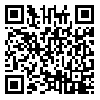Volume 8, Issue 2 (3-2018)
3 2018, 8(2): 5-14 |
Back to browse issues page
Abstract: (2126 Views)
Background & Aim: Global statistics indicate an increase in the population of people with stroke worldwide. Cerebrovascular disorder is the third leading cause of death in the United States. this study was done by the goal of survey The effect of slow stroke back massage on the quality of life in the elderly patient with hemiplegia consequent cerebrovascular accident
Material & Method: This is a single-blind randomized clinical trial performed in payambar azam hospital, tavan center of rehabilitation and elder care center of Gonbad-e-Kavos city in 1396. The sample size was 42 people, 21 of whom were in the experimental and control group, respectively. Sampling was performed in a 6-month period by available sampling method and the results were evaluated using a questionnaire of 8-dimensional quality of life measurements. Data were analyzed using descriptive statistics and independent t-test and Chi-square test.
Results: The mean scores after intervention in dimensions of physical & social function and general health were significant. In terms of physical function, in the experimental group, the mean and standard deviation of the score before and after the intervention were 40/24±22/90 and 69.45±18.79 (p<0/001) and in the control group 42/48±14/78 and 43/87±19/75 which was not statistically meaningful (p=0/412)
Conclusion: We conclude that slow stroke back massage is an effective way to improve the symptoms and function of the affected area and can be a complementary therapeutic method in rehabilitation of patients with brain strokes, which indicates that this non-pharmacological and complementary intervention improved of the quality of life of elderly patients.
Material & Method: This is a single-blind randomized clinical trial performed in payambar azam hospital, tavan center of rehabilitation and elder care center of Gonbad-e-Kavos city in 1396. The sample size was 42 people, 21 of whom were in the experimental and control group, respectively. Sampling was performed in a 6-month period by available sampling method and the results were evaluated using a questionnaire of 8-dimensional quality of life measurements. Data were analyzed using descriptive statistics and independent t-test and Chi-square test.
Results: The mean scores after intervention in dimensions of physical & social function and general health were significant. In terms of physical function, in the experimental group, the mean and standard deviation of the score before and after the intervention were 40/24±22/90 and 69.45±18.79 (p<0/001) and in the control group 42/48±14/78 and 43/87±19/75 which was not statistically meaningful (p=0/412)
Conclusion: We conclude that slow stroke back massage is an effective way to improve the symptoms and function of the affected area and can be a complementary therapeutic method in rehabilitation of patients with brain strokes, which indicates that this non-pharmacological and complementary intervention improved of the quality of life of elderly patients.
Type of Study: Research |
Subject:
Special
Received: 2018/04/10 | Accepted: 2018/04/10 | Published: 2018/04/10
Received: 2018/04/10 | Accepted: 2018/04/10 | Published: 2018/04/10
| Rights and permissions | |
 |
This work is licensed under a Creative Commons Attribution-NonCommercial 4.0 International License. |
